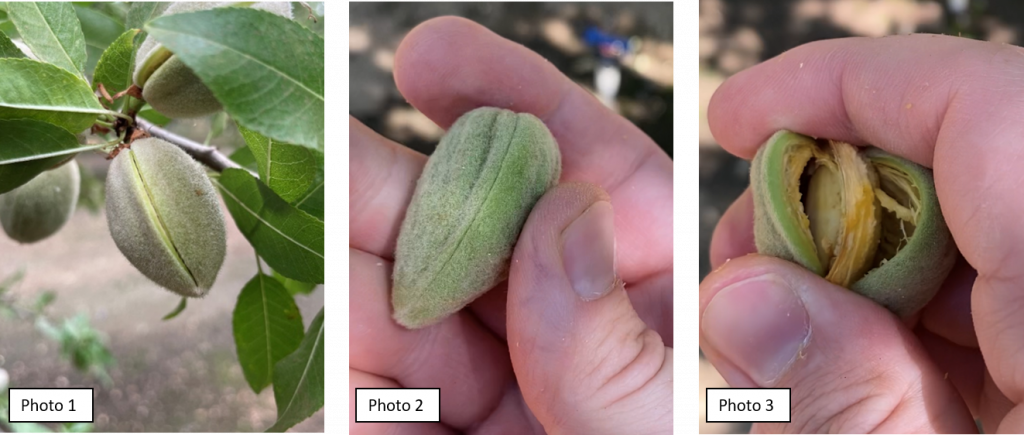Clarissa Reyes, North Sacramento Valley Orchard System Staff Research Associate
Luke Milliron, UCCE Farm Advisor, Butte, Glenn and Tehama Counties
Hull split is well underway, indicating almond harvest is imminent. Drought conditions, heat waves, and timing with other orchard activities can make irrigation challenging. Water stress can interfere with hull split, and if severe, can result in hull tights.
Hull split begins in the tree tops and progresses gradually to the lower interior of the canopy. Almonds are at hull split when they reach Stage 2C and show visible opening in the suture less than 3/8 inch (Photo 1). After hull split began, we recently observed nuts that appeared stalled at Stage 2B (Photo 2) for a week in highly water-stressed trees (trees in a different part of the orchard instrumented with FloraPulse sensors read between -19 and -21 bars, up to 16.5 bars drier than baseline). The percentage of nuts at hull split even appeared to decline in some trees during subsequent observations. A light squeeze applied to the ends of these 2B nuts caused the nuts to open at the suture, although the hull appeared to partially adhere to the shell (Photo 3). One day after the trees were irrigated nuts became more turgid and resumed hull split on their own. This was observed in nonpareils and test varieties at the CSU Chico variety trial.

Photo 1: Stage 2C, hull split
Photo 2: Stage 2B
Photo 3: Split with light hand pressure
Deficit irrigation research conducted by Prichard, Romero, Goldhamer, and others has shown a delayed rate of hull split and an increased occurrence of hull tights in water-stressed trees. Any harvest delay leaves nuts more vulnerable to hull rot and navel orangeworm. Joe Connell (Farm Advisor Emeritus) notes that if severe water stress is prolonged, hulls will dry down on the shell rather than split, resulting in an irreversible hull tight. Hull tights can decrease the value of harvested nuts because kernels must be cracked out, potentially producing damaged kernels and additional foreign material during hulling.
It’s important to monitor tree water status and maintain low-to-moderate water stress (2-8 bars drier than baseline; current baselines in recent hot weather range from -6 to -10) in trees to prevent water-stress induced hull tights. If hull split has stalled due to water-stress, an irrigation can effectively allow hull split to continue to completion.
During hull split it’s equally important to monitor tree water status and irrigate to 100% ET in the two weeks before harvest. Too much irrigation at this time can increase disease, delay shaking, and may increase the risk of shaker damage. Too little irrigation can increase mites, increase stick-tights, decrease kernel weight, and cause defoliation affecting next year’s bloom. When hull split in the lower interior of the tree canopy reaches 100 percent, consider a test shake to determine whether trees are ready for harvest.


Leave a Reply